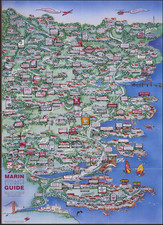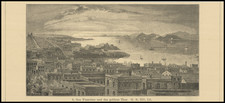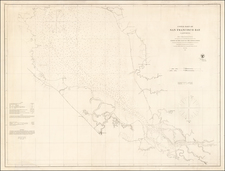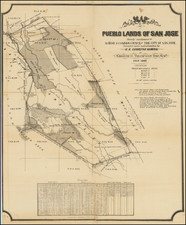Earliest San Francisco
Rare photographic reproduction of an original pencil sketch of San Francisco, drawn by Charles Austin Mendell Taber in October 1848.
The original sketch (apparently lost) was drawn by Charles A.M. Taber, brother of the photographer Isaiah West Taber, who would go on to a well-regarded career as an instrument maker in New Bedford, after an early career at sea as a whaler.
The drawing shows a very early and very primitive scene of the San Francisco waterfront, lacking piers or any meaningful signs of the Gold Rush. While gold was discovered in January 1848 and the first real dissemination of the news in San Francisco occurred in March 1848, the discovery was kept largely secret until after Treaty of Guadalupe Hidalgo was signed on May 30, 1848, and the first mention of the discovery on the east coast was in the New York Herald on August 19, 1848.
While dated October 1848, the biographical data for Taber makes the date of the original sketch subject to question. Taber was known to have been aboard whaling vessels in the Pacific as early as 1834. However, it is possible that the drawing may have been done in October 1849, as records suggest that Taber arrived in San Francisco in August 1849 and on to the gold diggings by September 1849. The simplicity of the townscape in the image itself certainly suggests a date of 1848.
We locate an example of the photograph in the Bancroft Library, copyrighted 1882, also bearing the date of October 1848. Taber seems to have also drawn sketch of Sacramento in October 1848.
Charles Austin Mendell Taber
Charles Austin Mendell Taber was born in 1824, in the region that would become Acushnet, Massachusetts. He embarked on a multifaceted career path that spanned the realms of maritime whaling, poetry, and amateur science. He would ultimately become captain of the whaling ship Millinocke.
Taber and at least 2 of his brothers arrived in the early years of the Gold Rush found several individuals with the surname Taber arriving on the shores of San Francisco Bay. In August 1849 Isaiah West Taber disembarked from the Friendship out of Fairhaven, Massachusetts. The following month saw the arrival of his brother, Charles Austin Mendell Taber, and a William H. Taber, possibly another brother, who sailed on the brig Rodolph with Harrison Eastman. Their father, Freeman Taber, was a shipwright from Buzzard's Bay in Massachusetts where whaling and the sea were the dominant way of life.
Evidence points to all three having gone to the mines. C. A. M. Taber was by the end of September sending a considerable amount of gold dust back to his father and he appears to have captained a ferry boat between Sacramento and San Francisco. William probably sailed to Sacramento on the Rodolph with Eastman and a fellow passenger, George Kent. It is known that, by 1851, he was back in San Francisco where he was a member of the Vigilance Committee. Isaiah West Taber tried ranching and dentistry but by the 1860s he had become a photographer in San Francisco, establishing his own studio in 1871.
Taber would go on to become an instrument maker by about 1860 in New Bedford. After his maritime career, Taber turned to writing, publishing “Rhymes from a Sailor's Journal” in 1873. This collection, capturing his seafaring experiences and reflections on New England life, exemplifies the broader 19th-century trend of personal narrative and regional literature. Additionally, Taber's later scientific publications demonstrate his ongoing engagement with contemporary debates and discoveries, particularly concerning geology and climate.












![(Native American Photograph) [Outdoor scene of six Wichita Indians playing cards at a ranch in Minco, Oklahoma Territory, with horse-drawn carriages in the background]](https://storage.googleapis.com/raremaps/img/small/93106.jpg)
![(California Photographs) [Album of 112 original photographs: San Diego and Los Angeles area, including La Jolla - Coronado - Sunset Cliffs - Lake Cuyamaca - Cuyamaca Dam & Valley -- Tia Juana (San Ysidro) -- Raymond Hotel in Pasadena - Shasta - Lick Observatory - Seattle]](https://storage.googleapis.com/raremaps/img/small/98892.jpg)


